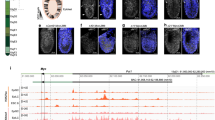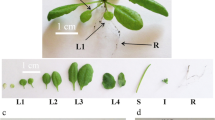Abstract
The tobacco nuclear matrix attachment region (MAR), RB7, has been shown to have a much greater effect on transgene expression in cultured cells than in transgenic plants. This is comparable to work in mouse systems showing that MARs have a positive effect on transgene expression in embryonic tissues but not adult tissues. There are several possible explanations for these observations. One is that cell differentiation state and proliferation rate can affect MAR function. We tested this possibility by initiating suspension cell cultures from well-characterized transgenic plants transformed with 35S::GUS with and without flanking MARs and then comparing GUS specific activity in the cell lines to those of the transgenic plants from which the cell lines were derived. If cell differentiation state and proliferation rate do affect MAR function, we would expect the ratio of transgene expression (cell suspensions : plants) to be greater in MAR lines than in control lines. This turned out not to be the case. Thus, it appears that MAR function is not enhanced simply because cells in culture divide rapidly and are not differentiated. Because in animal systems the chromosomal protein HMG-I/Y has been shown to be upregulated in proliferating cells and may have a role in MAR function, we have also examined the levels of the tobacco HMG-I/Y homolog by immunoblotting. The level of this protein does not differ between primary transformant cultured cells (NT-1) and Nicotiana tabacum plants (SR-1). However, a higher molecular weight cross-reacting polypeptide was found in nuclei from the NT-1 cell suspensions but was not detected in SR-1 leaf nuclei or cell suspensions derived from the SR-1 plants.
Similar content being viewed by others
References
Allen GC, Hall G Jr, Michalowski S, Newman W, Spiker S, Weissinger AK et al. (1996) High-level transgene expression in plant cells: effects of a strong scaffold attachment region from tobacco. Plant Cell 8: 899–913.
Allen GC, Spiker S and Thompson WF (2000) Use of matrix attachment regions (MARs) to minimize transgene silencing. Plant Mol Biol 43: 361–376.
Arwood LJ and Spiker S (1990) Binding of wheat and chicken high mobility group chromosomal proteins to DNA and to wheat and chicken mononucleosomes. J Biol Chem 265: 9771–9777.
Forrester WC, Genderen CV, Jenuwein T and Grossschedl R (1994) Dependence of enhancer-mediated transcription of the immunoglobin µ gene on nuclear matrix attachment regions. Science 265: 1221–1225.
Forrester WC, Fernandez LA and Grosschedl R (1999) Nuclear matrix attachment regions antagonize methylation-dependent repression of long-range enhancer-promoter interactions. Genes Dev 13: 3003–3014.
Goodwin GH, Cockerill PN, Kellam S and Wright CA (1985) Fractionation by high-performance liquid chromatography of the low-molecular-mass high-mobility-group (HMG) chromosomal proteins present in proliferating rat cells and an investigation of the HMG proteins present in virus transformed cells. Eur J Biochem 149: 41–51.
Grasser, KD (1995) Plant chromosomal high mobility group (HMG) proteins. Plant J 7: 185–192.
Gupta R, Webster CI, Walker AR and Gray JC (1997) Chromosomal location and expression of the single-copy gene encoding highmobility-group protein HMG-I/Y in Arabidopsis thaliana. Plant Mol Biol 34: 529–536.
Hall G Jr, Allen GC, Loer DS, Thompson WF and Spiker S (1991) Nuclear scaffolds and scaffold-attachment regions in higher plants. Proc Natl Acad Sci USA 88: 9320–9324.
Han KH, Ma CP and Strauss SH (1997) Matrix attachment regions (MARs) enhance transformation frequency and transgene expression in poplar. Transgenic Res 6: 415–420.
Hofmann WA, Cardon GH, Saedler H and Huisjer P (2000) Isolation of two cDNAs encoding AT-hook DNA-binding proteins, SAP1 and HMR1, from an Antirhinnum majus L. inflorescence expression library (Accession Nos. AJ132349 and AJ236702). Plant Physiol 122: 291.
Izaurralde E, Käs E and Laemmli UK (1989) Highly preferential nucleation of histone H1 assembly on scaffold-associated regions. J Mol Biol 210: 573–581.
Johnson KR, Disney JE, Wyatt CR and Reeves R (1990) Expression of mRNAs encoding mammalian chromosomal proteins HMGI and HMG-Y during cellular proliferation. Exp Cell Res 187: 69–79.
Käs E, Poljak L, Adachi Y and Laemmli UK (1993) A model for chromatin opening: stimulation of topoisomerase and restriction enzyme cleavage of chromatin by distamycin. EMBO J 12: 115–126.
Levée V, Garin E, Klimaszewska K and Séquin A (1999) Stable genetic transformation of white pine (Pinus strobus L.) after cocultivation of embryogenic tissues with Agrobacterium tumefaciens. Mol Breed 5: 429–440.
Maliga P, Lazar G, Svab Z and Nagy F (1976) Transient cycloheximide resistance in a tobacco cell line. Mol Gen Genet 149: 267–271.
Meijer AH, van Dijk EL and Hoge JHC (1996) Novel members of a family of AT hook-containing DNA-binding proteins from rice are identified through their in vitro interaction with consensus target sites of plant and animal homeodomain proteins. Plant Mol Biol 31: 607–618.
Schmitt F, Oakley EJ and Jost J P (1997) Antibiotics induce genomewide hypermethylation in cultured Nicotiana tabacum plants. J Mol Biol 272: 1534–1540.
Spiker S (1982) Histone variants in plants. J Biol Chem 259: 12007–12013
Spiker S (1984) High mobility group chromosomal proteins in wheat. J Biol Chem 259: 12007–12013.
Spiker S and Everett KM (1987) Blotting index of dissimilarity: use to study immunological relatedness of plant and animal high mobility group (HMG) chromosomal proteins. Plant Mol Biol 9: 431–442.
Spiker S and Thompson WF (1996) Nuclear matrix attachment regions and transgene expression in plants. Plant Physiol 110: 15–21.
Thompson EM, Christians E, Stinnakre MG and Renard JP (1994) Scaffold attachment regions stimulate HSP70.1 expression in mouse preimplantation embryos but not in differentiated tissues. Mol Cell Biol 14: 4694–4703.
Thompson EM, Legouy E, Christians E and Renard JP (1995) Progressive maturation of chromatin structure regulates HSP70.1 gene expression in preimplantation mouse embryo. Development 121: 3425–3437.
Tjaden G and Coruzzi GM (1994) A novel AT-rich DNA binding protein that combines an HMG I-like DNA binding domain with a putative transcription domain. Plant Cell 6: 107–118.
Ñlker B, Allen GC, Thompson WF, Spiker S and Weissinger AK (1999) A tobacco matrix attachment region reduces the loss of transgene expression in the progeny of transgenic tobacco plants. Plant J 18: 253–263.
Vain P, Worland B, Kohli A, Snape JW, Christou P, Allen GC et al. (1999) Matrix attachment regions increase transgene expression levels and stability in transgenic rice plants and their progeny. Plant J 18: 233–242.
Valvekens D, Van Montagu M and Van Lijsebettens M (1988) Agrobacterium tumefaciens-mediated transformation of Arabidopsis thaliana root explants using kanamycin selection. Proc Natl Acad Sci USA 85: 5536–5540.
Zhao K, Käs E, Gonzalez E and Laemmli UK (1993) SARdependent mobilization of H1 by HMG-I/Y in vitro: HMGI/ Y is enriched in H1-depleted chromatin. EMBO J 12: 3237–3247.
Author information
Authors and Affiliations
Rights and permissions
About this article
Cite this article
Ascenzi, R., Ingram, J.L., Massel, M. et al. The role of cell differentiation state and HMG-I/Y in the expression of transgenes flanked by matrix attachment regions. Transgenic Res 10, 465–470 (2001). https://doi.org/10.1023/A:1012082602587
Issue Date:
DOI: https://doi.org/10.1023/A:1012082602587




